【考研真题】2016上交汉硕专业二真题回忆版
- 格式:docx
- 大小:15.88 KB
- 文档页数:3
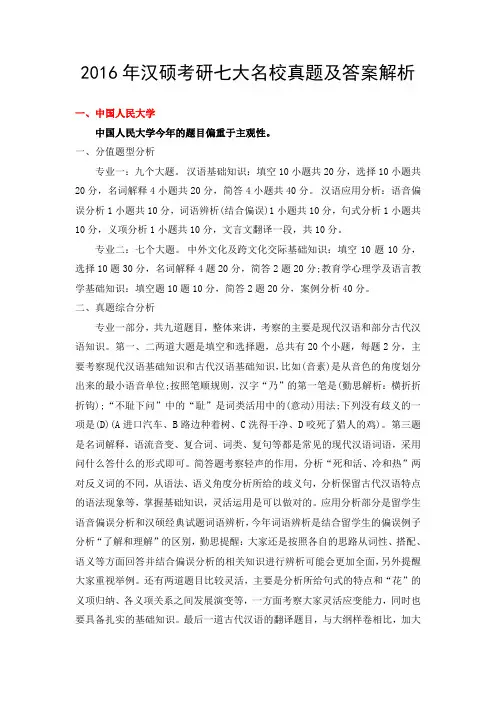
2016年汉硕考研七大名校真题及答案解析一、中国人民大学中国人民大学今年的题目偏重于主观性。
一、分值题型分析专业一:九个大题。
汉语基础知识:填空10小题共20分,选择10小题共20分,名词解释4小题共20分,简答4小题共40分。
汉语应用分析:语音偏误分析1小题共10分,词语辨析(结合偏误)1小题共10分,句式分析1小题共10分,义项分析1小题共10分,文言文翻译一段,共10分。
专业二:七个大题。
中外文化及跨文化交际基础知识:填空10题10分,选择10题30分,名词解释4题20分,简答2题20分;教育学心理学及语言教学基础知识:填空题10题10分,简答2题20分,案例分析40分。
二、真题综合分析专业一部分,共九道题目,整体来讲,考察的主要是现代汉语和部分古代汉语知识。
第一、二两道大题是填空和选择题,总共有20个小题,每题2分,主要考察现代汉语基础知识和古代汉语基础知识,比如(音素)是从音色的角度划分出来的最小语音单位;按照笔顺规则,汉字“乃”的第一笔是(勤思解析:横折折折钩);“不耻下问”中的“耻”是词类活用中的(意动)用法;下列没有歧义的一项是(D)(A进口汽车、B路边种着树、C洗得干净、D咬死了猎人的鸡)。
第三题是名词解释,语流音变、复合词、词类、复句等都是常见的现代汉语词语,采用问什么答什么的形式即可。
简答题考察轻声的作用,分析“死和活、冷和热”两对反义词的不同,从语法、语义角度分析所给的歧义句,分析保留古代汉语特点的语法现象等,掌握基础知识,灵活运用是可以做对的。
应用分析部分是留学生语音偏误分析和汉硕经典试题词语辨析,今年词语辨析是结合留学生的偏误例子分析“了解和理解”的区别,勤思提醒:大家还是按照各自的思路从词性、搭配、语义等方面回答并结合偏误分析的相关知识进行辨析可能会更加全面,另外提醒大家重视举例。
还有两道题目比较灵活,主要是分析所给句式的特点和“花”的义项归纳、各义项关系之间发展演变等,一方面考察大家灵活应变能力,同时也要具备扎实的基础知识。

上海外国语大学考研2016年现代汉语真题回忆版一、名词解释(要举例说明)(2’×5=10’)1、句法关系和语义关系2、比拟3、配价分析法4、语境5、单纯词二、填空(1’×10=10’)1、()是经过分析得出的最小的语音单位,能够区别意义的最小语音单位是()。
2、结构主义语言学各流派是以()的语言理论为基础的。
(《普通语言学教程》)是现代结构主义语言学的理论基础。
3、汉代初期,汉字传入日本,产生了“假名”。
晋初,汉字传入朝鲜和韩国,产生了()。
4、()是古汉字演变为现代汉字的转折点。
5、普通话语音的调类名称是()。
6、从语素在单词中所起的作用看,可以将语素分为表义语素和()。
7、()是词义构成的最小语义单位,也是词的区别性特征。
8、成语的构造总共有四种类型:(),复句结构,特殊结构,无理结构。
三、选择题(1’×10=10’)1、下列属于舌尖后、不送气、清、塞擦音的是()。
A.zB.cC.zhiD.chi2、双唇音不能和()韵母相拼?A.开口呼B.合口呼C.齐齿呼D.撮口呼3、元音与辅音根本区别是()。
A.发音方法不同B.在音节中的位置不同C.发音部位不同D.声带是否震动4、下列“一”的变调正确的是()。
A.看一(yí)看B.一(yī)干二净C.想一(yì)想D.一(yì)天到晚5、下列儿化韵读得不正确的是()。
A.拐弯儿(guǎiwānr-guǎiwāir)B.小曲儿(xiǎoqur-xiǎoquěr)C.香味儿(xiāngwèir-xiāngwèr)D.药方儿(yàofāngr-yàofãr)6、“兵、朱、舟”三个字的造字法分别是()。
A.指事、会意、象形B.会意、指事、象形C.象形、指事、会意D.会意、象形、指事7、下列成语书写正确的是()。
A.卑躬曲膝B.委屈求全C.膛目结舌D.杯盘狼藉8、短语“今天劳动节”、“特等茶叶”、“当他是傻瓜”、“游泳去”的结构类别分别为()。
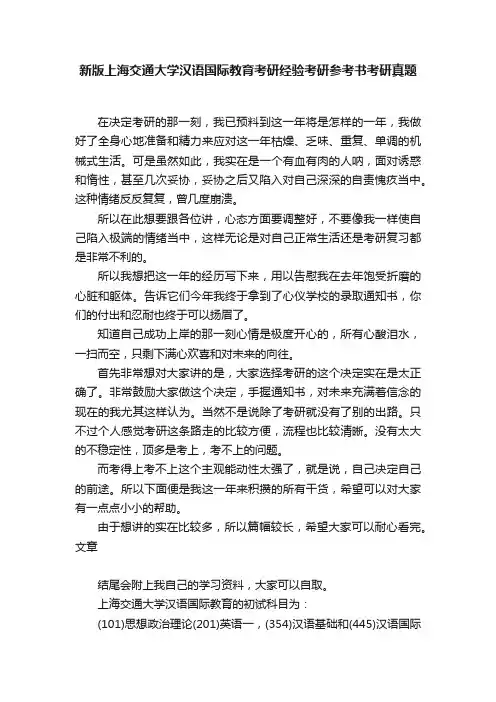
新版上海交通大学汉语国际教育考研经验考研参考书考研真题在决定考研的那一刻,我已预料到这一年将是怎样的一年,我做好了全身心地准备和精力来应对这一年枯燥、乏味、重复、单调的机械式生活。
可是虽然如此,我实在是一个有血有肉的人呐,面对诱惑和惰性,甚至几次妥协,妥协之后又陷入对自己深深的自责愧疚当中。
这种情绪反反复复,曾几度崩溃。
所以在此想要跟各位讲,心态方面要调整好,不要像我一样使自己陷入极端的情绪当中,这样无论是对自己正常生活还是考研复习都是非常不利的。
所以我想把这一年的经历写下来,用以告慰我在去年饱受折磨的心脏和躯体。
告诉它们今年我终于拿到了心仪学校的录取通知书,你们的付出和忍耐也终于可以扬眉了。
知道自己成功上岸的那一刻心情是极度开心的,所有心酸泪水,一扫而空,只剩下满心欢喜和对未来的向往。
首先非常想对大家讲的是,大家选择考研的这个决定实在是太正确了。
非常鼓励大家做这个决定,手握通知书,对未来充满着信念的现在的我尤其这样认为。
当然不是说除了考研就没有了别的出路。
只不过个人感觉考研这条路走的比较方便,流程也比较清晰。
没有太大的不稳定性,顶多是考上,考不上的问题。
而考得上考不上这个主观能动性太强了,就是说,自己决定自己的前途。
所以下面便是我这一年来积攒的所有干货,希望可以对大家有一点点小小的帮助。
由于想讲的实在比较多,所以篇幅较长,希望大家可以耐心看完。
文章结尾会附上我自己的学习资料,大家可以自取。
上海交通大学汉语国际教育的初试科目为:(101)思想政治理论(201)英语一,(354)汉语基础和(445)汉语国际教育基础(354)汉语基础和(445)汉语国际教育基础参考书目为:汉语基础:《现代汉语》(增订5版)黄伯荣、廖序东编高等教育出版社2011;《古代汉语》(第一册、第二册)王力主编中华书局1999;《语言学概论》王红旗主编北京大学出版社2008汉语国际教育基础:《中国文化要略》(第三版)程裕祯外语教学与研究出版社2011;《跨文化交际学概论》胡文仲外语教学与研究出版社1999年;《对外汉语教育学引论》刘珣北京语言文化大学出版社2000先说一下我的英语单词复习策略1、单词背单词很重要,一定要背单词,而且要反复背你只要每天背1-2个小时,不要去纠结记住记不住的问题,你要做的就是不断的背,时间久了自然就记住了。
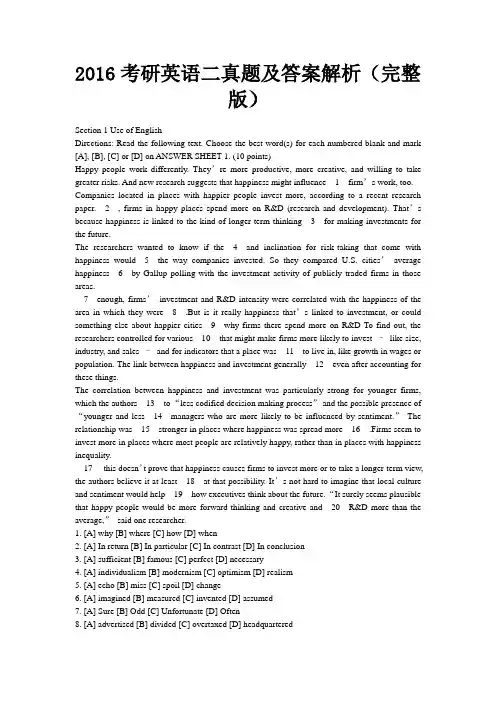
2016考研英语二真题及答案解析(完整版)Section 1 Use of EnglishDirections: Read the following text. Choose the best word(s) for each numbered blank and mark [A], [B], [C] or [D] on ANSWER SHEET 1. (10 points)Happy people work differently. They’re more productive, more creative, and willing to take greater risks. And new research suggests that happiness might influence__1__firm’s work, too. Companies located in places with happier people invest more, according to a recent research paper.__2__, firms in happy places spend more on R&D (research and development). That’s because happiness is linked to the kind of longer-term thinking__3__for making investments for the future.The researchers wanted to know if the__4__and inclination for risk-taking that come with happiness would__5__the way companies invested. So they compared U.S. cities’average happiness__6__by Gallup polling with the investment activity of publicly traded firms in those areas.__7__enough, firms’investment and R&D intensity were correlated with the happiness of the area in which they were__8__.But is it really happiness that’s linked to investment, or could something else about happier cities__9__why firms there spend more on R&D To find out, the researchers controlled for various__10__that might make firms more likely to invest –like size, industry, and sales –and for indicators that a place was__11__to live in, like growth in wages or population. The link between happiness and investment generally__12__even after accounting for these things.The correlation between happiness and investment was particularly strong for younger firms, which the authors__13__to “less codified decision making process”and the possible presence of “younger and less__14__managers who are more likely to be influenced by sentiment.”The relationship was__15__stronger in places where happiness was spread more__16__.Firms seem to invest more in places where most people are relatively happy, rather than in places with happiness inequality.__17__ this doesn’t prove that happiness causes firms to invest more or to take a longer-term view, the authors believe it at least__18__at that possibility. It’s not hard to imagine that local culture and sentiment would help__19__how executives think about the future. “It surely seems plausible that happy people would be more forward-thinking and creative and__20__R&D more than the average,”said one researcher.1. [A] why [B] where [C] how [D] when2. [A] In return [B] In particular [C] In contrast [D] In conclusion3. [A] sufficient [B] famous [C] perfect [D] necessary4. [A] individualism [B] modernism [C] optimism [D] realism5. [A] echo [B] miss [C] spoil [D] change6. [A] imagined [B] measured [C] invented [D] assumed7. [A] Sure [B] Odd [C] Unfortunate [D] Often8. [A] advertised [B] divided [C] overtaxed [D] headquartered9. [A] explain [B] overstate [C] summarize [D] emphasize10. [A] stages [B] factors [C] levels [D] methods11. [A] desirable [B] sociable [C] reputable [D] reliable12. [A] resumed [B] held [C]emerged [D] broke13. [A] attribute [B] assign [C] transfer [D]compare14. [A] serious [B] civilized [C] ambitious [D]experienced15. [A] thus [B] instead [C] also [D] never16. [A] rapidly [B] regularly [C] directly [D] equally17. [A] After [B] Until [C] While [D] Since18. [A] arrives [B] jumps [C] hints [D] strikes19. [A] shape [B] rediscover [C] simplify [D] share 20. [A] pray for [B] lean towards [C] give away [D] send out1. [标准答案] [C]how[考点分析] 连词辨析[选项分析] 根据语境,“新发现表明:快乐可能会影响工作__的稳定。
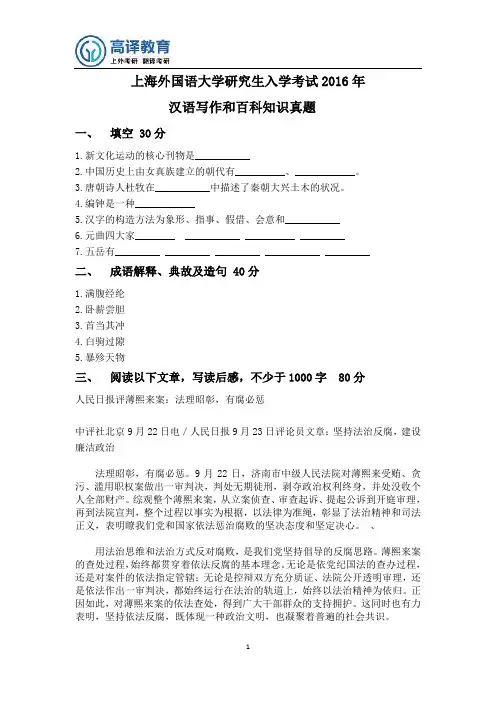
上海外国语大学研究生入学考试2016年汉语写作和百科知识真题一、填空 30分1.新文化运动的核心刊物是___________2.中国历史上由女真族建立的朝代有__________、____________。
3.唐朝诗人杜牧在___________中描述了秦朝大兴土木的状况。
4.编钟是一种____________5.汉字的构造方法为象形、指事、假借、会意和___________6.元曲四大家________ ___________ __________ _________7.五岳有_________ _________ _________ ___________ _________二、成语解释、典故及造句 40分1.满腹经纶2.卧薪尝胆3.首当其冲4.白驹过隙5.暴殄天物三、阅读以下文章,写读后感,不少于1000字 80分人民日报评薄熙来案:法理昭彰,有腐必惩中评社北京9月22日电/人民日报9月23日评论员文章:坚持法治反腐,建设廉洁政治法理昭彰,有腐必惩。
9月22日,济南市中级人民法院对薄熙来受贿、贪污、滥用职权案做出一审判决,判处无期徒刑,剥夺政治权利终身,并处没收个人全部财产。
综观整个薄熙来案,从立案侦查、审查起诉、提起公诉到开庭审理,再到法院宣判,整个过程以事实为根据,以法律为准绳,彰显了法治精神和司法正义,表明瞭我们党和国家依法惩治腐败的坚决态度和坚定决心。
、用法治思维和法治方式反对腐败,是我们党坚持倡导的反腐思路。
薄熙来案的查处过程,始终都贯穿着依法反腐的基本理念。
无论是依党纪国法的查办过程,还是对案件的依法指定管辖;无论是控辩双方充分质证、法院公开透明审理,还是依法作出一审判决,都始终运行在法治的轨道上,始终以法治精神为依归。
正因如此,对薄熙来案的依法查处,得到广大干部群众的支持拥护。
这同时也有力表明,坚持依法反腐,既体现一种政治文明,也凝聚着普遍的社会共识。
律己廉为首,治国法为先。
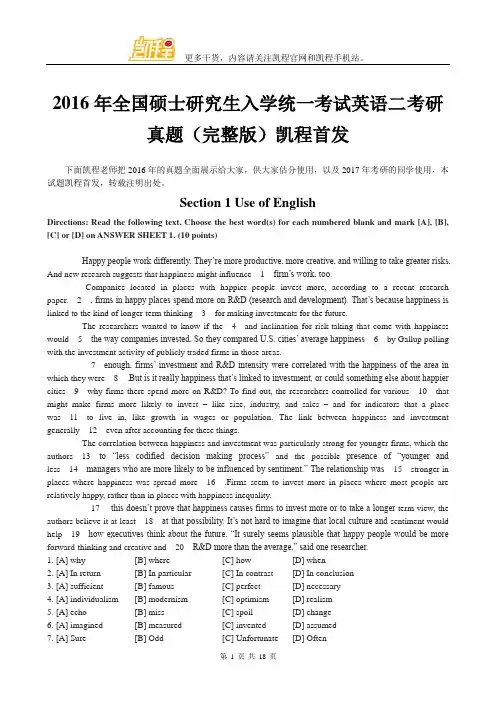
2016年全国硕士研究生入学统一考试英语二考研真题(完整版)凯程首发下面凯程老师把2016年的真题全面展示给大家,供大家估分使用,以及2017年考研的同学使用,本试题凯程首发,转载注明出处。
Section 1 Use of EnglishDirections: Read the following text. Choose the best word(s) for each numbered blank and mark [A], [B], [C] or [D] on ANSWER SHEET 1. (10 points)Happy people work differently. They’re more productive, more creative, and willing to take greater risks. And new research suggests that happiness might influence__1__firm’s work, too.Companies located in places with happier people invest more, according to a recent research paper.__2__, firms in happy places spend more on R&D (research and development). That’s because happiness is linked to the kind of longer-term thinking__3__for making investments for the future.The researchers wanted to know if the__4__and inclination for risk-taking that come with happiness would__5__the way companies invested. So they compared U.S. cities’ average happiness__6__by Gallup polling with the investment activity of publicly traded firms in those areas.__7__enough, firms’ investment and R&D intensity were correlated with the happiness of the area in which they were__8__.But is it really happiness that’s linked to investment, or could something else about happier cities__9__why firms there spend more on R&D? To find out, the researchers controlled for various__10__that might make firms more likely to invest –like size, industry, and sales –and for indicators that a place was__11__to live in, like growth in wages or population. The link between happiness and investment generally__12__even after accounting for these things.The correlation between happiness and investment was particularly strong for younger firms, which the authors__13__to ―less codified decision making process‖and the possible presence of ―younger and less__14__managers who are more likely to be influenced by sentiment.‖ The relationship was__15__stronger in places where happiness was spread more__16__.Firms seem to invest more in places where most people are relatively happy, rather than in places with happiness inequality.__17__ this doesn’t prove that happiness causes firms to invest more or to take a longer-term view, the authors believe it at least__18__at that possibility. It’s not hard to imagine that local culture and sentiment would help__19__how executives think about the future. ―It surely seems plausible that happy people would be more forward-thinking and creative and__20__R&D more than the average,‖ said one researcher.1. [A] why [B] where [C] how [D] when2. [A] In return [B] In particular [C] In contrast [D] In conclusion3. [A] sufficient [B] famous [C] perfect [D] necessary4. [A] individualism [B] modernism [C] optimism [D] realism5. [A] echo [B] miss [C] spoil [D] change6. [A] imagined [B] measured [C] invented [D] assumed7. [A] Sure [B] Odd [C] Unfortunate [D] Often8. [A] advertised [B] divided [C] overtaxed [D] headquartered9. [A] explain [B] overstate [C] summarize [D] emphasize10. [A] stages [B] factors [C] levels [D] methods11. [A] desirable [B] sociable [C] reputable [D] reliable12. [A] resumed [B] held [C]emerged [D] broke13. [A] attribute [B] assign [C] transfer [D]compare14. [A] serious [B] civilized [C] ambitious [D]experienced15. [A] thus [B] instead [C] also [D] never16. [A] rapidly [B] regularly [C] directly [D] equally17. [A] After [B] Until [C] While [D] Since18. [A] arrives [B] jumps [C] hints [D] strikes19. [A] shape [B] rediscover [C] simplify [D] share20. [A] pray for [B] lean towards [C] give away [D] send out1. [标准答案] [C]how[考点分析] 连词辨析[选项分析] 根据语境,“新发现表明:快乐可能会影响工作__的稳定。
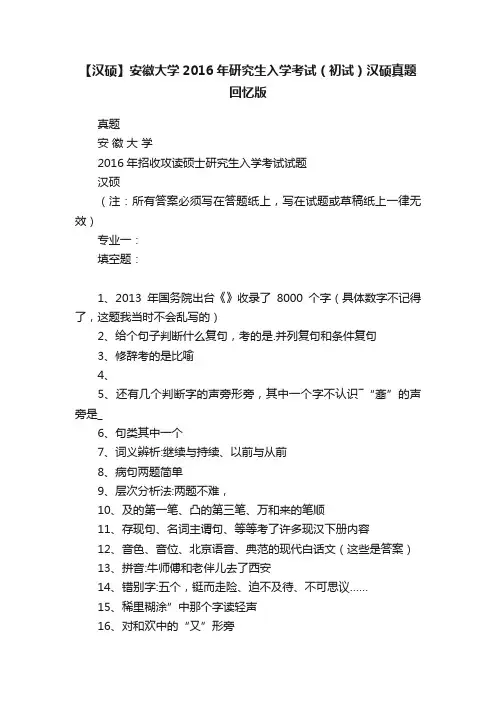
【汉硕】安徽大学2016年研究生入学考试(初试)汉硕真题
回忆版
真题
安徽大学
2016年招收攻读硕士研究生入学考试试题
汉硕
(注:所有答案必须写在答题纸上,写在试题或草稿纸上一律无效)
专业一:
填空题:
1、2013年国务院出台《》收录了8000个字(具体数字不记得了,这题我当时不会乱写的)
2、给个句子判断什么复句,考的是.并列复句和条件复句
3、修辞考的是比喻
4、
5、还有几个判断字的声旁形旁,其中一个字不认识―“齑”的声旁是_
6、句类其中一个
7、词义辨析:继续与持续、以前与从前
8、病句两题简单
9、层次分析法:两题不难,
10、及的第一笔、凸的第三笔、万和来的笔顺
11、存现句、名词主谓句、等等考了许多现汉下册内容
12、音色、音位、北京语音、典范的现代白话文(这些是答案)
13、拼音:牛师傅和老伴儿去了西安
14、错别字:五个,铤而走险、迫不及待、不可思议……
15、稀里糊涂”中那个字读轻声
16、对和欢中的“又”形旁
备注:安大专业课试卷为A4纸正反印刷答题纸为A3纸3张
安小研
千千万万的公众号中
能被你识别都是缘分
微信号:FL-anxiaoyan。
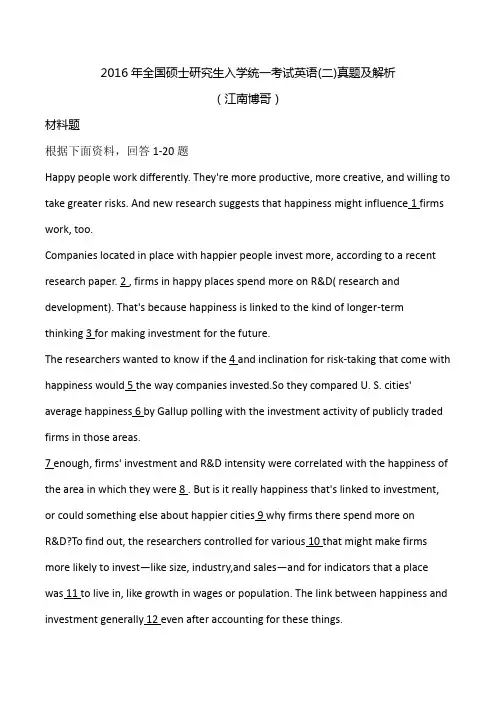
2016年全国硕士研究生入学统一考试英语(二)真题及解析(江南博哥)材料题根据下面资料,回答1-20题Happy people work differently. They're more productive, more creative, and willing to take greater risks. And new research suggests that happiness might influence1firms work, too.Companies located in place with happier people invest more, according to a recent research paper.2, firms in happy places spend more on R&D( research and development). That's because happiness is linked to the kind of longer-term thinking3for making investment for the future.The researchers wanted to know if the4and inclination for risk-taking that come with happiness would5the way companies invested.So they compared U. S. cities' average happiness6by Gallup polling with the investment activity of publicly traded firms in those areas.7enough, firms' investment and R&D intensity were correlated with the happiness of the area in which they were8. But is it really happiness that's linked to investment, or could something else about happier cities9why firms there spend more onR&D?To find out, the researchers controlled for various10that might make firms more likely to invest—like size, industry,and sales—and for indicators that a place was11to live in, like growth in wages or population. The link between happiness and investment generally12even after accounting for these things.The correlation between happiness and investment was particularly strong for younger firms, which the authors13to "less confined decision making process"and the possible presence of "younger and less14managers who are more likely to be influenced by sentiment. " The relationship was15stronger in places where happiness was spread more16. Firms seem to invest more in places where most people are relatively happy, rather than in places with happiness inequality.17this doesn't prove that happiness causes firms to invest more or to take alonger-term view, the authors believe it at least18at that possibility. It's not hard to imagine that local culture and sentiment would help19how executives think about the future. "It surely seems plausible that happy people would be moreforward-thinking and creative and20R&D more than the average, " said one researcher.1、[单选题]第(1)题选______.A.whyB.whereC.howD.when正确答案:C参考解析:空格句的大意:新的研究表明,幸福感可能也会影响公司______的工作。
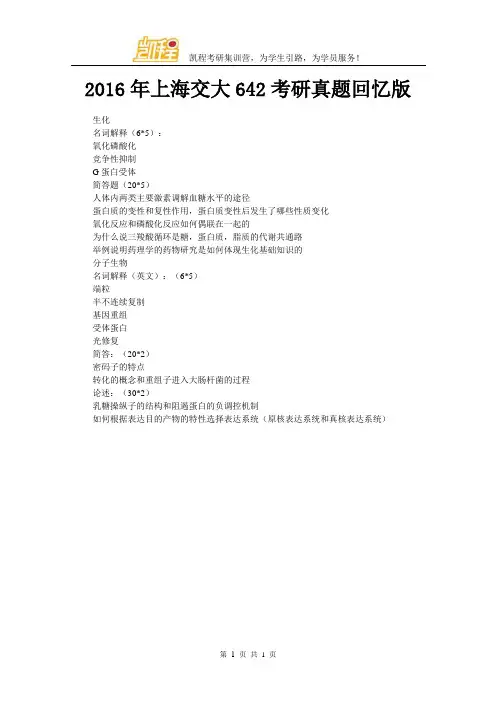
凯程考研集训营,为学生引路,为学员服务!
第 1 页 共 1 页 2016年上海交大642考研真题回忆版 生化
名词解释(6*5):
氧化磷酸化
竞争性抑制
G 蛋白受体
简答题(20*5)
人体内两类主要激素调解血糖水平的途径
蛋白质的变性和复性作用,蛋白质变性后发生了哪些性质变化
氧化反应和磷酸化反应如何偶联在一起的
为什么说三羧酸循环是糖,蛋白质,脂质的代谢共通路
举例说明药理学的药物研究是如何体现生化基础知识的
分子生物
名词解释(英文):(6*5)
端粒
半不连续复制
基因重组
受体蛋白
光修复
简答:(20*2)
密码子的特点
转化的概念和重组子进入大肠杆菌的过程
论述:(30*2)
乳糖操纵子的结构和阻遏蛋白的负调控机制
如何根据表达目的产物的特性选择表达系统(原核表达系统和真核表达系统)。
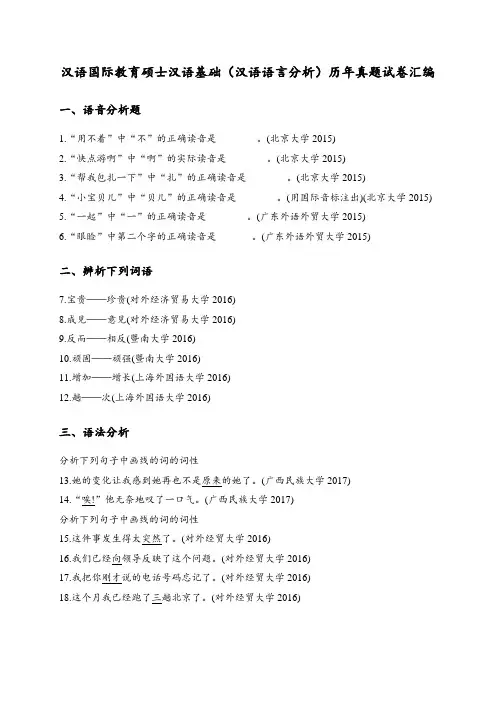
汉语国际教育硕士汉语基础(汉语语言分析)历年真题试卷汇编一、语音分析题1.“用不着”中“不”的正确读音是________。
(北京大学2015)2.“快点游啊”中“啊”的实际读音是________。
(北京大学2015)3.“帮我包扎一下”中“扎”的正确读音是________。
(北京大学2015)4.“小宝贝儿”中“贝儿”的正确读音是________。
(用国际音标注出)(北京大学2015)5.“一起”中“一”的正确读音是________。
(广东外语外贸大学2015)6.“眼睑”中第二个字的正确读音是_______。
(广东外语外贸大学2015)二、辨析下列词语7.宝贵——珍贵(对外经济贸易大学2016)8.成见——意见(对外经济贸易大学2016)9.反而——相反(暨南大学2016)10.顽固——顽强(暨南大学2016)11.增加——增长(上海外国语大学2016)12.趟——次(上海外国语大学2016)三、语法分析分析下列句子中画线的词的词性13.她的变化让我感到她再也不是原来的她了。
(广西民族大学2017)14.“唉!”他无奈地叹了一口气。
(广西民族大学2017)分析下列句子中画线的词的词性15.这件事发生得太突然了。
(对外经贸大学2016)16.我们已经向领导反映了这个问题。
(对外经贸大学2016)17.我把你刚才说的电话号码忘记了。
(对外经贸大学2016)18.这个月我已经跑了三趟北京了。
(对外经贸大学2016)19.“我来拿成绩单”,“他拿来了一本书”,“我们要怎么样来怎么样”,谈谈三个“来”的联系和区别。
(复旦大学2014)四、修改病句20.姐姐下星期快要结婚了。
(复旦大学2014)21.我已经很久没有见面我的女朋友了。
(复旦大学2014)22.妈妈把我的衣服洗洗了。
(复旦大学2014)23.谢谢你们鼓掌,拍马屁我。
(北京外国语大学2015)24.我找我的老师,老的男人。
(北京外国语大学2015)25.今天我参观了高老师。

全国汉语国际教育硕士(语言学纲要)历年真题试卷汇编一、填空题1.格语法的代表人物是______________(国名)的______________、(人名),系统功能语言学的代表人物是______________(国名)的______________(人名)。
2.种语言中的句子数量是无限的,人类之所以能掌握语言,是因为构成句子的语言材料和______________是十分有限的。
3.文字突出的作用是打破了有声语言的______________和______________的局限,扩大了有声语言的使用范围。
4.语言的接触有不同的类型,其中最常见的是______________。
二、判断题5.动物掌握“语言”是先天的本领,人类掌握语言则需通过后天学习。
( ) (A)正确(B)错误6.同一言语社团的人总是固定使用一种语言形式。
( )(A)正确(B)错误选择题---为题目类型7.“香”和“花”这两个符号可以组合成“香花”,也可以组合成“花香”,这说明符号的( )。
(A)任意性(B)随意性(C)线条性(D)可变性8.下列形态属于语法范畴中的“体”的是( )。
(A)I am coming.(B)He writes.(C)A tree is broken.(D)You shall drink.9.下列词中,属于仿译词的是( )。
(A)基因(B)卡片(C)牛津(D)剑桥10.汉语普通话语音系统中没有的发音部位是( )。
(A)双唇(B)齿间(C)唇齿(D)舌面前11.汉语中的“了、着、过”在古代具有实实在在的词汇意义,到现代成为表示类似体的意义的构形语素。
这是( )。
(A)虚化(B)异化(C)类推(D)语法范畴的变化三、多项选择题12.北京话鼻音聚合群中的三个音位在组合关系中有很大的差异,/m/只能出现在元音前,(A)同一聚合群中的音位不具备相同的组合关系(B)聚合系统中出现不对称现象是语言发展的结果(C)虽然聚合系统会出现不平行不对称的现象,但是平行和对称仍然是音位系统的重要特点(D)对称系统中的不对称现象为语言发展提供线索四、名词解释13.音质音位与非音质音位14.上下义词和类义词15.皮钦语五、问答题16.用你所熟悉的外语与汉语相比较,具体说明现代汉语(普通话)的语音、词汇和语法特点(要三方面各举一例)。
【考研真题】上海交通大学对外汉语考研真题考研对于许多学子来说,是一场充满挑战与机遇的征程。
而对于那些有志于从事对外汉语教学的同学,上海交通大学的对外汉语专业考研更是备受关注。
今天,就让我们一起来深入了解一下上海交通大学对外汉语考研的真题。
上海交通大学作为一所国内知名的高等学府,其对外汉语专业的考研真题具有一定的难度和综合性。
首先,在专业基础知识方面,真题涵盖了语言学、现代汉语、古代汉语等多个领域。
语言学部分的真题常常会涉及语言的本质、语言的结构和功能、语言的发展变化等重要概念。
例如,会让考生分析语言符号的任意性和线条性特征,或者探讨语言和思维的关系。
现代汉语的真题则注重对语音、词汇、语法、文字等方面的考查。
可能会要求考生辨析近义词的差异,分析句子的结构成分,或者解释现代汉语中的一些特殊语法现象。
比如,“他连我都不认识”这个句子中“连……都……”的语法意义和作用是什么。
古代汉语的真题可能会包括文言文的阅读理解、古代汉语词汇和语法的知识。
考生需要具备一定的文言文阅读能力,能够解释古代汉语中的实词、虚词的用法,以及分析古代汉语的句式结构。
除了专业基础知识,上海交通大学的对外汉语考研真题还注重对考生语言应用能力的考查。
这包括汉语的写作和翻译能力。
在写作方面,可能会给出一个特定的话题,要求考生用规范、准确、流畅的汉语进行论述。
例如,让考生谈谈对汉语国际教育中文化教学的看法。
这不仅考验考生的语言表达能力,还考查了他们对专业领域的理解和思考。
翻译部分,可能会有汉译英和英译汉的题目。
汉译英部分会选取一些具有中国特色的文化、社会等方面的内容,要求考生准确地用英语表达出来;英译汉则会涉及一些与语言学、教育相关的英文文献,考查考生对专业术语和复杂句子结构的理解和翻译能力。
此外,真题中还可能会有一些与对外汉语教学相关的案例分析题。
比如,给出一个具体的教学场景,让考生分析其中存在的问题,并提出相应的教学改进方案。
这就要求考生不仅要掌握扎实的专业知识,还要具备一定的教学实践经验和问题解决能力。
2016年翻译硕士考研信息选择题((每小题1分,共10分)1.人们能把一张张静止的画面看成连续活动的电影,正是()作用的结果。
A.短时记忆B.长时记忆C.逻辑记忆D.感觉记忆2.马斯洛把生理需要,安全需要,归属于爱的需要和()归为缺失需要,它是个体生存错必须的。
A.尊重需要B.美得需要C.求职的需要自我实现的需要3.许多学生愿意学习语言,即使不一定得到学分,获得高分,也会持之以恒的钻研,这属于()。
A.外部动机B.内部动机C.附属内驱力D.自我提高内驱力4.维纳对归因于理论进行了系统的探讨,把能力归为()音素。
A.内部,稳定B.内部。
不稳定C.外部,稳定D.外部,不稳定5.几百年的不同教学论思潮所形成的教学过程模式多种多样,具有代表性的模式大体有以下四种,传授式,发现式,活动式和()。
A.发展式B.启发式C.产生式D.任务式6.下面哪一项不属于普遍的教学原则(),A.巩固性原则B.直观性原则C.力量型原则D.协调性原则7.在第二语言学习的理论中,认为第二语言习得的过程中学习者有其自己的内大纲的学者为()。
A.拉多B.舒曼C.科德D.塞林克8.想要测量听力理解能力,却采用笔头回答问题的方法,说的是测验的()问题。
9.语言测试的质量评析,可以从有效性,可靠性,区分性和可进行性及()几个方面进行。
A.信度B.效度C.难度D.反馈作用10.分析教学方法的流派主要应从三个方面着手,教学法的理论基础,()和采取的教学方法。
A.教学原则B.教学对象C.教学过程D.教学背景案例分析与写作根据以下材料,按照“发现问题_____分析问题______解决问题”的思路,写一篇1500字以上的案例分析,要求观点明确,材料充实,结构严谨,条理清楚,语言规范,卷面整洁。
赵刚系对汉语语教育学研二学生,在一次对外汉语实习教学课堂上,就“吃狗肉”现象,班内俄罗斯,中国,美国及来自其他不同文化地域背景的学生展开了激烈的讨论,课堂气氛异常紧张,出现尴尬局面,当学生问到赵刚时,赵刚也发表意见,而是带过。
2016年全国硕士研究生招生考试英语(二)(科目代码:204)☆考生注意事项☆1.答题前,考生须在试题册指定位置上填写考生编号和考生姓名;在答题卡指定位置上填写报考单位、考生姓名和考生编号,并涂写考生编号信息点。
2.考生须把试题册上的“试卷条形码”粘贴条取下,粘贴在答题卡的“试卷条形码粘贴位置”框中。
不按规定粘贴条形码而影响评卷结果的,责任由考生自负。
3.选择题的答案必须涂写在答题卡相应题号的选项上,非选择题的答案必须书写在答题卡指定位置的边框区域内。
超出答题区域书写的答案无效;在草稿纸、试题册上答题无效。
4.填(书)写部分必须使用黑色字迹签字笔书写,字迹工整、笔迹清楚;涂写部分必须使用2B铅笔填涂。
5.考试结束,将答题卡和试题册按规定交回。
(以下信息考生必须认真填写)考生编号考生姓名2016年全国硕士研究生入学统一考试英语(二)试题Directions:Section IUse of EnglishRead the followin g text. Choose the best word(s) for each numbered blank and mark A, B, C or D on the ANSWER SHEET. (lOpoints)Happ y people work differentl y . The y 're more productive, more creative, and willin g to take greater risks. And new research su gg ests that happiness mi g ht influence 1 firms work, too.Companies located in places with happier people invest more, accordin g to a recent research paper. 2 , 伍ms in happ y places spend more on R&D (research and development). That's because happiness is linked to the kind of lon g er-term thinkin g 3 for makin g investments for the future.The researchers wanted to know if the 4 and inclination for risk-takin g that come with happiness would 5 the wa y companies invested. So the y compared U.S. cities'avera g e happiness 6 b y Gallup pollin g with the investment activit y of publicl y traded firms in those areas.7 enou g h, fim函investment and R&D intensity were correlated with the happiness of the area in which the y were 8 . But is it reall y happiness that's linked to investment, or could somethin g else about happier cities 9 wh y 伍ms there spend more on R&D? To find out, the researchers controlled for various 10 that mi g ht make 伍ms more likel y to invest like size, industry, and sales and for indicators that a place was 11 to live in, like growth in wa g es or population. The link between happiness and investment g enerall y 12 even after accountin g for these thin g s.The correlation between happiness and investment was particularl y stron g fory oun g er firms, which the authors 13to "less codified decision makin g process" and the possible presence of ''y oun g er and less 14 mana g ers who are more likel y to be influenced b y sentiment." The relationship was 15 stron g er in places where happiness was spread more 16 . Firms seem to invest more in places where most people are relativel y happ y , rather than in places with happiness inequality.17 this doesn't prove that happiness causes firms to invest more or to take a lon g er-term view, the authors believe it at least 18 at that possibility. It's not hard to ima g ine that local culture and sentiment would help 19 how executives think about the future. "It surel y seems plausible that happ y people would be more forward-thinkin g and creative and 20 R&D more than the avera g e," said one researcher.1.[A]wh y[B]how[C]where[D]when2.[A] In return[B]In particular[C]In contrast[D]In conclusion3.[A] necessary[B]famous[C]perfect[D]sufficient4.[A] individualism [B] realism[C]o p ti m ism[D]modernism5.[A] miss[B]echo[C]spoil[D]c ha n ge6.[A] imagined[B]measured[C]assumed[D]invented7.[A] Sure[B]O dd[C]Unfortunate [D] Often8.[A] divided[B]advertised[C]overtaxed[D]headquartered9.[A] summarize[B]overstate[C]ex pl ain[D]emphasize10.[A] factors[B]st a ge s[C]levels[D]methods11.[A] desirable[B]sociable[C]reliable[D]reputable12.[A] resumed[B]emerged[C]held[D]broke13. [A] ass ign [B]attribute[C]transfer[D]compare14.[A] serious[B]civilized[C]a m bitious[D]experienced15.[A] instead[B]thus[C]also[D]never16.[A] r ap idly[B]di r ec t ly[C]re g ul arly[D]e qu a ll y17.[A] While[B]Until[C]After[D]Since18.[A] arrives[B]jump s[C]hints[D]strikes19.[A] share[B]rediscover[C]simplify[D]sha p e20.[A] pray for[B]lean towards[C]send out[D]gi ve awaySection II Reading ComprehensionPart ADirections:Read the following four texts. Answer the questions after each text by choosing A, B, C or D. Mark your answers on the ANSWER SHEET. (40 points)Text 1It's true that hi g h-school codin g classes aren't essential for learnin g computer science in colle g e. Students without experience can catch up after a few introductory courses, said Tom Cortina, the assistant dean at Carne g ie Mellon's School of Computer Science.However, Cortina said, earl y exposure is beneficial. When y oun g er kids learn computer science, the y learn that it's not just a confusin g, endless strin g of letters and numbers—but a tool to build apps, or create artwork, or test hypotheses. It's not as hard for them to transform their thou g ht processes as it is for older students. Breakin g down problems into bite-sized chunks and usin g code to solve them becomes normal. Givin g more children this trainin g could increase the number of people interested in the field and help fill the jobs g ap, Cortina said.Students also benefit from learnin g somethin g about codin g before the y g et to colle g e, where introductory computer-science classes are packed to the brim, which can drive the less-experienced or -determined students away.The Flatiron School, where people pa y to learn pro g rammin g, started as one of the man y codin g bootcamps that's become popular for adults lookin g for a career chan g e. The hi g h-schoolers g et the same curriculum, but "we try to g ear lessons toward thin g s the y're interested in," said Victoria Friedman, an instructor. For instance, one of the apps the students are developin g su gg ests movies based on y our mood.The students in the Flatiron class probabl y won't drop out of hi g h school and build the next Facebook. Programmin g langua g es have a quick turnover, so the "Rub y on Rails" langua g e the y learned ma y not even be relevant b y the time the y enter the job market. But the skills the y learn how to think lo g icall y through a problem and or g anize the results appl y to an y codin g langua g e, said D eborah Seehom, an education consultant for the state of N orth Carolina.Indeed, the Flatiron students mi g ht not g o into IT at all. But creatin g a future arm y of coders is not the sole purpose of the classes. These kids are g oin g to be surrounded b y computers in their pockets, in their offices, in their homes for the rest of their lives. The y oun g er the y learn how computers think, how to凶埜the machine into producin g what the y want the earlier the y learn that the y have the power to do that the better.21.Cortina holds that early exposure to computer science makes 1t easier to.[A]co mp lete future job training[B]remodel the way of thinking[C]formulate logical hypotheses[D]perfect artwork production22.In delivering lessons for high-schoolers, Flatiron has considered their.[A]expenence[B]interest[C]career prospects[D]academic backgrounds23.Deborah Seehom believes that the skills learned at Flatiron will[A]help students learn other computer languages[B]have to be upgraded when new technologies come[C]need i mp roving when students look for jobs[D]enable students to make big quick money24. According to the last paragraph, Flatiron students are expected to.[A]bring forth innovative computer technologies[B]stay longer in the information technology industry[C]become better prepared for the digitalized world[D]co mp ete with a future army of programmers25.The word "coax" (Line 4, Para. 6) is closest in meaning to.[A]pers u ade[B]fri g ht en[C]m isguide[D]challengeText2Biologists estimate that as man y as 2 million lesser prairie chickens—a kind of bird living on stretching grasslands—once lent red to the often gre y landscape of the midwestem and southwestern United States. But just some 22,000 birds remain toda y, occup y ing about 16% of the species'historic range.The crash was a major reason the U.S. Fish and Wildlife Service (USFWS) decided to formall y list the bird as threatened. "The lesser prairie chicken is in a desperate situation," said USFWS D irector D aniel Ashe. Some environmentalists, however, were disappointed. The y had pushed the agenc y to designate the bird as "endangered," a status that gives federal officials greater regulatory power to crack down on threats. But Ashe and others argued that the "threatened" tag gave the federal government flexibility to try out new, potentiall y less confrontational conservation approaches. In particular, the y called for forging closer collaborations with western state governments, which are often uneas y with federal action, and with the private landowners who control an estimated 95% of the prairie chicken's habitat.Under the plan, for example, the agenc y said it would not prosecute landowners or businesses that unintentionall y kill, harm, or disturb the bird, as long as the y had signed a range-wide management plan to restore prairie chicken habitat. Negotiated b y USFWS and the states, the plan requires individuals and businesses that damage habitat as part of their operations to pa y into a fund to replace every acre destro y ed with 2 new acres of suitable habitat. The fund will also be used to compensate landowners who set aside habitat. USFWS also set an interim goal of restoring prairie chicken populations to an annual average of 67,000 birds over the next 10 y ears. And it gives the Western Association of Fish and Wildlife Agencies (W A FW A), a coalition of state agencies, the job of monitoring progress. Overall, the idea is to let "states remain in the driver's seat for managing the species," Ashe said.Not everyone bu y s the win-win rhetoric. Some Congress members are trying to block the plan, and at least a dozen industry groups, four states, and three environmental groups are challenging it in federal court. Not surprisingl y, industry groups and states generall y argue it goes too far; enviromnentalists sa y it doesn't go far enough. "The federal government is giving responsibilit y for managing the bird to the same industries that are pushing it to extinction," sa y s biologist Ja y Lininger.26.The major reason for listing the lesser p rairie chicken as threatened is.[A]its drastically decreased population[B]the underestimate of the grassland acreage[C]a desperate appeal from some biologists[D]the insistence of private landowners27.The "threatened" tag disappointed some environmentalists in that it.[A]was a give-in to governmental pressure[B]would involve fewer agencies in action[C]granted less federal regulatory power[D]went against conservation policies28.It can be learned from Paragraph 3 that unintentional harm-doers will not beprosecuted if they[A]agree to pay a sum for compensation[B]volunteer to set up an equally big habitat[C]offer to support the W AFW A monitoringjob[D]promise to raise funds for USFWS operations29. According to Ashe, the leading role in managing the species is.[A]the federal government[B]the wildlife agencies[C]the landowners[D]the states30.Jay Lininger would most likely support.[A]industry groups[B]the win-win rhetoric[C]environmental groups[D]the plan under challengeText3That everyone's too bus y these da y s is a cliche. But one specific complaint is made especiall y mournfull y: There's never an y time to read.What makes the problem thornier is that the usual time-mana g ement techni q ues don't seem sufficient. The web's full of articles offerin g tips on makin g time to read: "Give up TV" or "Carry a book with y ou at all times." But in m y experience, usin g such methods to free up the odd 30 minutes doesn't work. Sit down to read and the fl yw heel of work-related thou g hts keeps spinnin g or else ou're so exhausted that a challen g in g book's the last thin g y ou need. The modem ymind, Tim Parks, a novelist and critic, writes, "is overwhelmin g l y inclined toward con皿unication…It is not simpl y that one is interrupted; it is that one is actuall y inclined to interruption." D eep readin g re q uires not just time, but a special kind of time which can't be obtained merel y b y becomin g more efficient.In fact, "becomin g more efficient" is part of the problem. Thinkin g of time as a resource to be maximised means y ou approach it instnunentall y, jud g in g an yiven moment as well spent onl y in so far as it advances pro g ress toward some g oal. gImmersive readin g, b y contrast, depends on bein g willin g to risk inefficienc y,oallessness, even time-wastin g. Try to slot it in as a to-do list item and y ou'll gmana g e onl y g oal-focused readin g useful, sometimes, but not the most fulfillin g kind. "The future comes at us like empt y bottles alon g an unstoppable and nearl y infinite conve y or belt," writes Gary Eberle in his book Sacred Time, and''we feel a pressure to fill these different-sized bottles (da y s, hours, minutes) as the y pass, for if the y g et b y without bein g filled, we will have wasted them." No mind-set could be worse for losin g y ourself in a book.So what does work? Perhaps surprisin g l y, schedulin g re g ular times for readin g. You'd think this mi g ht fuel the efficienc y mind-set, but in fact, Eberle notes, such ritualistic behaviour helps us "step outside time's flow" into "soul time." You could limit distractions b y readin g onl y ph y sical books, or on sin g le-purpose e-readers. "Carry a book with y ou at all times" can actuall y work, too providin g y ou dip in often enou g h, so that readin g becomes the default state from which y ou temporaril y surface to take care of business, before droppin g back down. On a reall y g ood da y, it no lon g er feels as if y ou're "makin g time to read," but just readin g, and makin g time for everythin g else.31.The usual time-management techniques don't work because.[A]what they can offer does not ease the modem mind[B]what challenging books demand is repetitive reading[C]what people often forget is carrying a book with them[D]what deep reading requires cannot be guaranteed32.The "empty bottles" metaphor illustrates that people feel a pressure to.[A]update their to-do lists[B]make passing time fulfilling[C]carry their plans through[D]pursue carefree reading33.Eberle would agree that scheduling regular times for reading helps.[A]encourage the efficiency mind-set[B]develop online reading habits[C]promote ritualistic reading[D]achieve immersive reading34."Carry a book with you at all times" can work if.[A]reading becomes your primary business of the day[B]all the daily business has been promptly dealt with[C]you are able to drop back to business after reading[D]time can be evenly split for reading and business35.The best title for this text could be[A]How to Enjoy Easy Reading[B]How to Find Time to Read[C]How to Set Reading Goals[D]How to Read ExtensivelyText4Against a backdro p of drastic changes in econom y and p o p ulation structure, y ounger Americans are drawing a new 21st-century road ma p to success, a latest p oll has found.Across generational lines, Americans continue to p rize many of the same traditional milestones of a successful life, including getting married, having children, owning a home, and retiring in their sixties. But while y oung and old mostl y agree on what constitutes the finish line of a fulfilling life, the y off er strikingl y different p aths for reaching it.Young p eo p le who are still getting started in life were more likel y than older adults to p rioritize p ersonal fulfillment in their work, to believe the y will advance their careers most b y regularl y changing jobs, to favor communities with more p ublic services and a faster p ace of life, to agree that cou p les should be financiall y secure before getting married or having children, and to maintain that children are best served b y two p arents working outside the home, the surve y found.From career to community and famil y , these contrasts suggest that in the aftermath of the searing Great Recession, those just starting out in life are definingp riorities and ex p ectations that will increasingl y s p read through virtuall y all as p ects of American life, from consumer p references to housing p atterns to p olitics.Young and old converge on one ke y p oint: Overwhelming majorities of both grou p s said the y believe it is harder for y oung p eo p le today to get started in life than it was for earlier generations. While y ounger p eo p le are somewhat more o p timistic than their elders about the p ros p ects for those starting out toda y , big majorities in both grou p s believe those "just getting started in life" face a tougher climb than earlier generations in reaching such si gnp ost achievements as securing a good-p a y ing job, starting a famil y , managing debt, and finding affordable housing.Pete Schneider considers the climb tougher toda y . Schneider, a 27-y ear-old auto technician from the Chicago suburbs, sa y s he struggled to find a job after graduating from college. Even now that he is working steadil y , he said, "I can't afford to p a y m y monthl y mortgage p ayments on m y own, so I have to rent rooms out to p eo p le to make that ha pp en." Looking back, he is struck that his p arents could p rovide a comfortable life for their children even though neither had completed college when he was y oung. "I still grew u p in an u pp er middle-class home with p arents who didn't have college degrees," Schneider said. "I don't think p eo p le are ca p able of that anymore."36.One cross-generation mark of a successful life is.[A]trying out different lifestyles[B]having a family with children[C]working beyond retirement age[D]setting up a profitable business37.It can be learned from Paragraph 3 that young people tend to.[A]favor a slower life pace[B]hold an occupation longer[C]attach importance to pre-marital finance[D]give priority to childcare outside the home38.The priorities and expectations defined by the young will.[A]become increasingly clear[B]focus on materialistic issues[C]depend largely on political preferences[D]reach almost all aspects of A merican life39.Both young and old agree that.[A]good-p aying j obs are less availab le[B]the old made more life achievements[C]housing loans today are easy to obtain[D]getting established is harder for the young40.Which of the following is true about Schneider?[A]He found a dream job after graduating from college.[B]His parents believe working steadily is a must for success.[C]His parents'good life has little to do with a college degree.[D]He thinks his job as a technician quite challenging.PartBDirections:Read the following text and answer the questions b y choosing the most suitable subheading from the list A-G for each of the numbered paragraphs (41-45). There are two extra subheadings which y ou do not need to use. Mark y our answers on the ANSWER SHEET. (10 points)[A]Be sill y[B]Have fun[C]Ask for help[D]Express y our emotions[E]D on't overthink it[F]Be easil y pleased[G]Notice thingsAct Your Shoe Size, Not Your AgeAs adults, it seems that we are constantl y pursuing happiness, often with mixed results. Yet children appear to have it down to an art and for the most part the y don't need self-help books or therap y. Instead, the y look after their wellbeing instinctivel y, and usuall y more effectivel y than we do as grownups. Perhaps it's time to learn a few lessons from them.41.What does a child do when he's sad? He cries. When he's angry? He shouts. Scared? Probabl y a bit of both. As we grow up, we learn to control our emotions so the y are manageable and don't dictate our behaviours, which is in many wa y s a good thing. But too often we take this process too far and end up suppressing emotions, especiall y negative ones. That's about as effective as brushing dirt under a carpet and can even make us ill. What we need to do is find a wa y to acknowledge and express what we feel appropriatel y, and then again, like children move on.42.A couple of Christmases ago, m y y oungest stepdaughter, who was nine y ears old at the time, got a Superman T-shirt for Christmas. It cost less than a fiver but she was overjo y ed, and couldn't stop talking about it. Too often we believe that a new job, bigger house or better car will be the magic silver bullet that will allow us to finall y be content, but the reality is these things have very little lasting impact on our happiness levels. Instead, being grateful for small things every da yis a much better wa y to improve wellbein g.43.Have y ou ever noticed how much children lau g h? If we adults could indul g e in a bit of silliness and g i gg lin g, we would reduce the stress hormones in our bodies, increase g ood hormones like endorphins, improve blood flow to our hearts and even have a greater chance of fi g htin g off infection. All of which would, of course, havea positive effect on our happiness levels.44.The problem with bein g a grownup is that there's an awful lot of serious stuff to deal with work, mort g a g e payments, fi g urin g out what to cook for dinner. But as adults we also have the luxury of bein g able to control our own diaries and it's important that we schedule in time to enjo y the thin g s we love. Those thin g s mi g ht be social, sportin g, creative or completel y random (dancin g around the livin g room, an y one?) it doesn't matter, so lon g as the y're enjo y able, and not likel y to have ne g ative side effects, such as drinkin g too much alcohol or g oin g ona wild spendin g spree if y ou're on a ti g ht bud g et.45.Havin g said all of the above, it's important to add that we shouldn't try too hard to be happ y. Scientists tell us this can backfire and actuall y have a ne g ative i mp act on our wellbein g. As the Chinese philosopher Chuan g Tzu is reported to have said: "Happiness is the absence of strivin g for happiness." And in that, once more, we need to look to the example of our children, to whom happiness is not a oal but a natural byproduct of the wa y the y live.gSection III Translation46.DirectionsTranslate the following text into Chinese. Write y our translation on the ANSWER SHEET. (15 points)The supermarket is designed to lure customers into spending as much time as possible within its doors. The reason for this is simple: The longer y ou sta y in the store, the more stuff y ou'll see, and the more stuff y ou see, the more y ou'll bu y. And supermarkets contain a lot of stuff. The average supermarket, according to the Food Marketing Institute, carries some 44,000 different items, and man y carry tens of thousands more. The sheer volume of available choice is enough to send shoppers into a state of information overload. According to brain-scan experiments, the demands of so much decision-making quickl y become too much for us. After about 40 minutes of shopping, most people stop struggling to be rationall y selective, and instead begin shopping emotionall y which is the point at which we accumulate the 50 percent of stuff in our cart that we never intended bu y ing.Section IV WritingPartA47.Directions:Suppose you won a translation contest and your friend, Jack, wrote an email to congratulate you and ask for advice on translation. Write h im a reply to1)thank him, and2)give your advice.You should write about 100 words on the ANSWER SHEET.Do not use your own name. Use "Li Ming" insteadDo not write your address. (10 points)PartB48.Directions:Write an essay based on the chart below. In your writing, you should1)interpret the chart, and2)give your comments.You should write about 150 words on the ANSWER SHEET. (15 points)其他培养独立能力6务广交朋友9%缓解压力33%某高校学生旅游目的调查2016年全国硕士研究生入学统一考试英语(二)试题Section I: Use of English (10 points)1 - 5: BBACD6 - 10: BADCA11-15: ACBDC16-20: DACDBSection II: Reading Comprehension (50 points)21-25: BBACA26-30: ACADC31-35: DBDAB36-40: BCDDC41-45: DFABESection III :Translation (15 Points)超市旨在吸引消费者在店里停留尽可能长的时间。
【考研真题】2016上交汉硕专业二真题回忆版文化要略部分1. (二里头文化)河南偃师市,其时代与夏文化吻合,已被认定就是夏文化。
2. “春秋五霸”一般指齐桓公、晋文公、楚庄王、秦穆公和(宋襄公)。
3. 日本僧人(空海)就学于惠果,回国后创立了真言宗。
4. “喇嘛”是藏语译音,意思是上师。
(√)5. “大乘”强调“慈悲一切众生,力主以功德回报他人”,无论是谁,只要行慈济世,普度众生,并按照佛教戒律不断净化自己,就可以达到净土佛国,就可以解脱成佛。
(√)6. 文殊菩萨有“大智”,普贤菩萨有“大行”,地藏菩萨有“(大愿)”,观音菩萨有“大慈”。
7. 伊斯兰教的教义集中在该教信封的(《古兰经》)里。
8. 唐宋时期,来华的阿拉伯商人逐渐增多,不少人侨居在中国的京城和沿海城市,由于信奉伊斯兰教,需要经常做礼拜,就比较集中地住在一处,形成所谓的“番坊”。
(√)9. 诸侯国的大学叫“(泮宫)”。
10. 荀子当时曾担任齐宣王在都城设立的“稷下学宫”的祭酒。
(√)11. 明代国子监取代国子学,成为国家唯一的最高学府。
(√)12. 南宋四大书院为岳麓、白鹿洞、丽泽、(象山)书院。
13. 殿试分三甲录取,一甲第一名为状元。
(√)14. 以(司马光)的《资治通鉴》为代表,是按历史编年体分述历史事件。
15. 纪传体与《二十五史》?(具体记不起来,好像问《二十五史》是否属于纪传体)16. 南宋史学家(袁枢)把《资治通鉴》改编为239个专题的《通鉴纪事本末体》。
17. 人们把杜佑的《通典》、郑樵的《通志》、马端临的(《文献统考》)合称为“三通”。
18. 现存最早的类书是隋代末年虞世南编的《北堂书钞》。
(√)19. 《元和郡县制》是迄今保存最早的全国性地方志。
(题目给的是《华阳国志》。
)20. 私藏的书阁中“南三阁”是扬州的“文汇阁”,镇江“文宗阁”,杭州的“(文澜阁)。
”21. 由著名学者(纪昀|纪晓岚)执笔写成《四库全书总目》。
2016北京师范大学汉语国际教育硕士(汉硕)真题回忆+经验考试时间:2015.12.26~27与其他学校相比,北师大的命题比较基础,没有偏题怪题,但考得很全面。
建议复习的时候一定要全面,之前北师大的专业二一直以现当代为主,结果今年考了很多古代文学,我压根就没看,是一大失误。
考得基础,并不意味这轻松。
相反,这警示我们:每一题都相当重要,如果你失误了,没有题目可以供你扳回。
并且英语和政治很有可能成为区分成绩的关键。
由于本人英语和政治都复习得不好,就简单谈谈专业课吧,望对学弟学妹有所帮助。
专业一:《现代汉语》(黄廖第五版)重中之重,要读得滚瓜乱熟、字斟句酌,更要能举一反三、灵活运用。
尤其是语法那一章,每一个点都要背熟,修辞可以略看。
可以买一本有答案的练习题。
这本书,我背了5遍,已经算少的了。
古代汉语只考标点和解释字句。
到图书馆借一本战国策或者左传之类的书,三四天读一小段,培养语感即可。
印象中没有考语纲,另外要看《101例》(暨大出版,网上有PDF版)专业二:文化:买带笔记的《中国文化要略》,一边看书一边补充笔记,从第二遍开始就只看笔记背。
这个不太难,感觉考到的都是那种不看书也知道的点。
不会的大部分都来自课外,这个就只能靠个人积累了,这里推荐一下《汉语国际教育基础考点测评》。
背完这本书,外国文化部分就没问题啦。
除此之外,一定要注意积累,关注北京和全国的大事件。
另外,北师大极爱考政治题。
复习政治的形势与政策时,要留心一下国内顶尖重要的几个政策方针。
文学:《中国现代三十年》(钱理群)《中国文学史》(袁行霈,共四本)《外国文学史》(郑克鲁,共两本),如果能背完真的就可以了。
文学部分只要记人物、作品、主要风格、世人公认的评价即可,古代文学还要记体裁风格特点和千古名篇佳句。
还是要以现当代为重点,今年考的现当代的作品都是名人之作,但不是名人的代表作,要求我们一定要对原著内容的主人公和情节有所了解,不能只记条条框框了。
【考研真题】2016上交汉硕专业二真题回忆版
文化要略部分
1. (二里头文化)河南偃师市,其时代与夏文化吻合,已被认定就是夏文化。
2. “春秋五霸”一般指齐桓公、晋文公、楚庄王、秦穆公和(宋襄公)。
3. 日本僧人(空海)就学于惠果,回国后创立了真言宗。
4. “喇嘛”是藏语译音,意思是上师。
(√)
5. “大乘”强调“慈悲一切众生,力主以功德回报他人”,无论是谁,只要行慈济世,普度众生,并按照佛教戒律不断净化自己,就可以达到净土佛国,就可以解脱成佛。
(√)
6. 文殊菩萨有“大智”,普贤菩萨有“大行”,地藏菩萨有“(大愿)”,观音菩萨有“大慈”。
7. 伊斯兰教的教义集中在该教信封的(《古兰经》)里。
8. 唐宋时期,来华的阿拉伯商人逐渐增多,不少人侨居在中国的京城和沿海城市,由于信奉伊斯兰教,需要经常做礼拜,就比较集中地住在一处,形成所谓的“番坊”。
(√)
9. 诸侯国的大学叫“(泮宫)”。
10. 荀子当时曾担任齐宣王在都城设立的“稷下学宫”的祭酒。
(√)
11. 明代国子监取代国子学,成为国家唯一的最高学府。
(√)
12. 南宋四大书院为岳麓、白鹿洞、丽泽、(象山)书院。
13. 殿试分三甲录取,一甲第一名为状元。
(√)
14. 以(司马光)的《资治通鉴》为代表,是按历史编年体分述历史事件。
15. 纪传体与《二十五史》?(具体记不起来,好像问《二十五史》是否属于纪传体)
16. 南宋史学家(袁枢)把《资治通鉴》改编为239个专题的《通鉴纪事本末体》。
17. 人们把杜佑的《通典》、郑樵的《通志》、马端临的(《文献统考》)合称为“三通”。
18. 现存最早的类书是隋代末年虞世南编的《北堂书钞》。
(√)
19. 《元和郡县制》是迄今保存最早的全国性地方志。
(题目给的是《华阳国志》。
)
20. 私藏的书阁中“南三阁”是扬州的“文汇阁”,镇江“文宗阁”,杭州的“(文澜阁)。
”
21. 由著名学者(纪昀|纪晓岚)执笔写成《四库全书总目》。
22. 东方(苍龙)七宿:角、亢、氐、房、心、尾、箕。
23. 周代的商高提出了直角三角形的“勾三股四弦五”为世界上最早关于勾股定理的记录。
24. 我国中医学的“八纲”为(阴、阳、表、里、寒、热、虚、实)。
25. 张仲景为医学巨著《金匮要略的》的作者。
(√)
26. 对针灸疗法的探讨与总结,到魏晋时有(皇甫谧)的《针灸甲乙经》。
27. 中国造纸术8世纪时传入阿拉伯,后经阿拉伯传入欧洲,欧洲人才结束了用羊皮纸书写的历史。
(√)
28. “汉三宫”为长乐宫、未央宫、(建章宫)。
29. “唐三宫”为太极宫、大明宫和(兴庆宫)。
30. 努尔哈赤的陵墓为(福陵)。
31. 赵匡胤的陵墓位于(河南巩义市)。
PS:这套题书上没有,为10年新闻内容,大家可以具体百度。
32. 世上记载较早的关是豫陕边境的(函谷关)。
33. 全世界最早的敞肩拱桥是(赵州桥)。
34. 我国古代最长的石拱桥是江苏省苏州市的(宝带桥)。
35. 现存较大的寺庙园林是山西省太原市的“晋祠”,最早是纪念晋国创始人唐叔虞的祠庙。
(√)PS:卷子原题是错的,把那个唐叔虞调换成另外一个人,具体我回忆不起来。
36. 素称“东南名园之冠”的是上海市的(豫园)。
37. 辽阳白塔、北京天宁寺和慈寿寺属于(密檐式)。
38. 在现在的陕西省泾阳县内战国时期韩国水工郑国修建的水利工程是(郑国渠)。
39. 女诗人蔡琰|蔡文姬的著作主要有《悲愤诗》和《胡笳十八拍》。
(√)
40. “汉赋四大家”为司马相如、班固、(扬雄)、张衡。
41. 元末明初重要的传奇作品有高则成的《琵琶记》。
PS:此题为选择题,选空不记得是高则成还是《琵琶记》,不好意思!
42. 宋元以来由于市民阶层的兴起,产生了与市民艺术趣味相关的白话小说——“话本”,其主要内容有“小说”和(“讲史”)。
43. 唐初四大书法家是(虞世南)、欧阳询、褚遂良、薛稷。
44. (阎立本)画迹流传到今天的还有《历代帝王图卷》、《步辇图》。
45. 明代写意花鸟画的大师当推徐渭。
(√)
46. 目前在中国境内发现的两大玉器时代的文化遗址,一是北方辽河流域的“红山文化”。
二是南方太湖地区的(“良渚文化”)。
47. 成语“完璧归赵”中的“和氏璧”为(南阳玉)。
48. 明清时代的“官窑”特指“中国瓷都”景德镇为宫廷生产瓷器。
(√)
49. 中国四大名砚之首为(端砚)。
50. 明朝以后,文官用鸟,一品仙鹤,二品(锦鸡),三品孔雀,四品云雁,五品白雉。
51. 比利时人(柏应理)于1687年在巴黎出版《中国哲学家孔子》。
52. 根据天干地支法,算1866年还是哪一年属于什么()年。
53. ……祭地为琮……(√)
54. 古希腊四大学派:犬儒主义学派,斯多亚学派,伊壁鸠鲁学派,新柏拉图学派。
试题给了一句有关道德方面的话,让判断是其中哪个学派……
外汉教育学引论部分
55. 人们普遍认为大脑(左半球)存在三个语言功能区。
56. 结构主义语言学
57. 形象记忆的概念认知。
PS:就是给出一个例子,让你分辨这是形象记忆还是逻辑记忆等。
58. 感觉记忆。
PS:也是选择题,考试方法如上。
59. 记忆过程包括:识记、保持、再认和重现四个基本环节。
60. “格式塔心理学”反对把意识化解成元素,主张把心理作为一个整体组织来研究。
(√)
61. 人本主义心理学是本世纪60年代在美国兴起的一个心理学派,创始人(马斯洛)。
62. 行为主义心理学的“刺激——反应”论盛行于40年代到50年代,代表人物是(斯金纳)。
63. 美国语言学家(塞林克)于1969年提出中介语概念。
64. 科德是偏误分析最早的倡导者,把学习者所犯的错误分为失误和偏误两种。
PS:不记得是用哪个填空,sorry!
65. 元认知策略就是学习者通过计划、(监控)、和评估等方式对自己的认知过程进行反思和研究。
66. (场依存性)是易于感知事物整体的认知方式,倾向于从宏观上看事物并把事物作为一个整体来对待。
67. 语法翻译法的心理学基础是18世纪德国(官能心理学),其创始人是德国哲学家沃尔夫。
68. 情景法的概念和代表人物。
69. 全身反应法创始人阿舍尔。
(√)
70. 交际法一反其他教学法以语法或者句型结构为纲的传统做法,明确提出以功能为纲的概念。
71. 教材编写和选用原则“五性”为:针对性、实用性、科学性、趣味性和系统性。
(√)
72. 教学过程的基本阶段:感知、理解、巩固、运用。
(√)
73. 水平测试概念。
PS:题目就是拿一种考试让你选择这种考试属于哪一种测试类型。
74. 语言测试的评析标准,可以从效度、信度、区分性和(可行性)及反馈作用几个方面进行。
75. (结构效度)是最重要的效度,是效度的核心问题。
案例分析
留学生李华初次出国,到达美国后不久,被朋友请去参加一个聚会,他准时到达,却发现许多人姗姗来迟,穿得也很随便。
在聚台上,只有几种饮料和简单的食物,没有什么像样的菜,聚会上熟人很少,好不容易见到了马克,于是与他攀谈起来,谈了大约十来分钟,马克说他要和另外一个朋友谈谈,就走开了,李华非常失望。
聚会的主人把他介绍给一两个人,然后就再也不管他。
两个钟头后,他借故离开了聚会。
回到家,他还很饿,不得不煮些苗条吃。
他决心以后再也不参加这类聚会了。